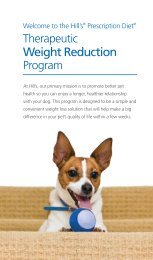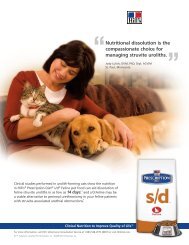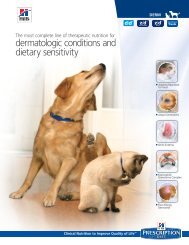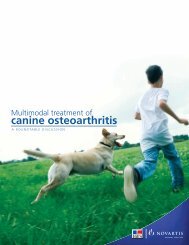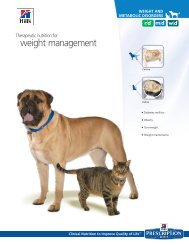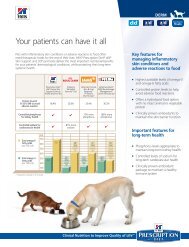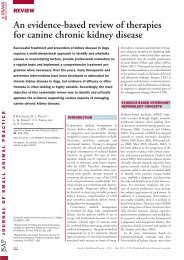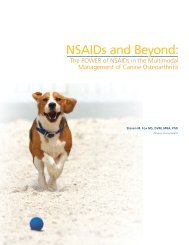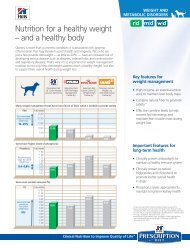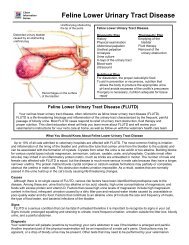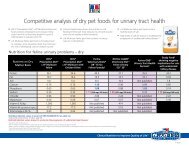using nutrition to ease the pain of osteoarthritis - HillsVet
using nutrition to ease the pain of osteoarthritis - HillsVet
using nutrition to ease the pain of osteoarthritis - HillsVet
Create successful ePaper yourself
Turn your PDF publications into a flip-book with our unique Google optimized e-Paper software.
<strong>nutrition</strong> myths and truths, facts and fallacies<br />
hip joint<br />
KNEE joint<br />
healthy hip joint<br />
arthritic hip joint healthy knee joint arthritic knee joint<br />
Figure 2: Radiographic images <strong>of</strong> healthy and arthritic hip and knee joints demonstrating typical changes<br />
thickening <strong>of</strong> <strong>the</strong> joint capsule, sclerosis or erosion <strong>of</strong> <strong>the</strong> subchondral bone, periarticular osteophyte formation,<br />
en<strong>the</strong>siophytes, and joint mice (Fig. 2).<br />
Arthrocentesis and synovial fluid analysis: Synovial fluid collected from affected joints is examined for<br />
volume, color, clarity, viscosity, cy<strong>to</strong>logy, and biochemical analysis. Fluid from patients with OA may be clear or<br />
pale yellow and slightly turbid due <strong>to</strong> an incr<strong>ease</strong> in inflamma<strong>to</strong>ry cells. It typically contains synovial cells and<br />
less than 5 x 10 3 /L mononuclear cells (and a few red blood cells may also be present). Polymorphonuclear cells<br />
typically constitute 0-12% <strong>of</strong> cells. Synovial fluid analysis alone may not differentiate OA joints from normal<br />
joints (particularly in <strong>the</strong> early stages <strong>of</strong> OA), but is valuable in ruling out septic and immune-mediated arthritis.<br />
Physical<br />
Rehabilitation<br />
NSAID<br />
Adjunct<br />
Multimodal<br />
Osteoarthritis<br />
Management<br />
Weight Control<br />
and Exercise<br />
EPA-rich<br />
Diet<br />
Figure 3: Multimodal management <strong>of</strong><br />
<strong>osteoarthritis</strong><br />
Chondroprotectant<br />
Treatment Of OA<br />
Multimodal medical treatment is recommended for OA, including<br />
weight reduction, proper <strong>nutrition</strong>, exercise control, physical<br />
<strong>the</strong>rapy, and <strong>the</strong> administration <strong>of</strong> anti-inflamma<strong>to</strong>ry medications,<br />
analgesics, and <strong>osteoarthritis</strong> dis<strong>ease</strong> modifying agents (Fig. 3).<br />
Exercise and Physical Rehabilitation: Exercise and physical <strong>the</strong>rapy<br />
are <strong>of</strong>ten used as part <strong>of</strong> <strong>the</strong> treatment for OA in humans and dogs.<br />
Exercise reduces obesity (a primary contribu<strong>to</strong>r <strong>to</strong> <strong>the</strong> progression <strong>of</strong><br />
OA) and controlled exercise may help improve strength and range<br />
<strong>of</strong> motion in joints. Exercise may also reduce <strong>the</strong> need for analgesic<br />
medications. Low-impact exercises such as walking and swimming<br />
are preferred. The activity should be initiated gradually and incr<strong>ease</strong>d<br />
as joint function improves. Warm compresses, coldpacks, massage<br />
<strong>the</strong>rapy, electro<strong>the</strong>rapy, and ultrasound are techniques used in<br />
treatment <strong>of</strong> both human and canine OA patients.<br />
Nutrition: Fish oil as a source <strong>of</strong> omega-3 fatty acids has been shown <strong>to</strong> reduce inflammation and <strong>pain</strong> in<br />
mammals. Certain omega-3 fatty acids have been shown <strong>to</strong> reduce <strong>the</strong> expression and activity <strong>of</strong> proteoglycandegrading<br />
enzymes, <strong>the</strong>reby having <strong>the</strong> potential <strong>to</strong> s<strong>to</strong>p <strong>the</strong> progression <strong>of</strong> <strong>osteoarthritis</strong> (Fig.4). Damaged<br />
chondrocytes produce inflamma<strong>to</strong>ry cy<strong>to</strong>kines that contribute <strong>to</strong> <strong>the</strong> progression <strong>of</strong> OA through catabolic



